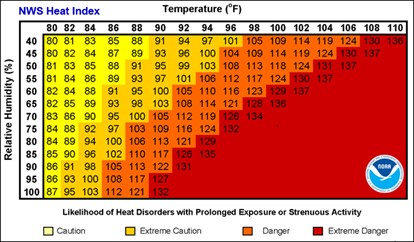High Heat Hazards
by Bob Buddemeier
It’s summer, and the world is hotter than ever. Not only that, but elderly (or downright old) people are more vulnerable to the dangerous effects of heat. And, we are getting older as the climate gets warmer. A bad combination.
The Complement has a long-standing tradition – two, maybe three years – of reissuing an article on preparing for emergencies that are due to, or occur in, high temperatures. To refresh your survival skills, click the following link. https://thecomplement.info/2022/03/03/hotsy-totsy-a-review/
However, that article considers only dehydration, which is far from the only way to be killed or disabled by excessive heat. To round out your worry inventory, we’ll discuss how you can get killed by heat by: (1) Not drinking enough; (2) Drinking too much; or (3) Spending too much time in the wrong environment, independent of your drinking habits. Do not rely on this brief summary – see the CDC website on Heat Stress and Heat Related Illnesses – especially heat stroke and heat exhaustion
Before going any further, let’s specify that by “drinking,” we mean drinking water or a beverage that is primarily water. It’s best to avoid alcohol and caffeine, BUT it is better to have coffee or beer than to go without fluids. For reasons we’ll get to below, isotonic beverages (e.g., most “sports drinks” like Gatorade) can be desirable in hot weather – these have the same salt concentrations as your body fluids, so they keep your internal chemistry in balance when your water balance starts bouncing around.
The Three Horsemen of Heat:
- Dehydration – you sweat and excrete more water than you take in by eating and drinking. You can dehydrate yourself at almost any temperature by not drinking enough, but it’s a lot easier to get in trouble when it is hot and you sweat a lot. With a combination of high temperature and physical exertion, a person can sweat as much as three gallons per day.
Fortunately, there is a straightforward, simple way to track your hydration state – monitor the color of your urine. And if you can’t produce anything to look at, take immediate emergency action. Assuming you can pee in or on something that will facilitate examination, the chart below tells you what you need to do.

- Sodium depletion (hyponatremia) – too much water in or going through your system washes out or dilutes the sodium in your body fluids, with potentially disastrous consequences for your physiological processes. This doesn’t have to be heat-related; diarrhea or vomiting can cause it, especially if lost fluids are replaced with water rather than isotonic fluids. However, hot weather may inspire people to drink large quantities of water without enough salt intake through food or drink.
- Heat stress – your body cools itself by evaporating sweat. If you can’t sweat, or more likely if your sweat can’t evaporate, your body just gets hotter and hotter until your core temperature stays above 104o F for a while. Then you’re toast, although pretty soggy toast.
When does this happen, other than when you are too dehydrated to sweat? That’s what the Heat Index is about. When the air is moist (high humidity), evaporation is inhibited, so your sweat does not cool you off by turning into vapor. The Heat Index is measured in degrees, but it is temperature adjusted for humidity – and the higher the humidity, the lower the temperature at which you can get into trouble. The table from the National Weather Service Heat Index page is shown below (click link for more info). See also the PBS Terra video at https://www.youtube.com/watch?v=vqBrL8BokSk&t=12s.
IMPORTANT NOTE — these values are calculated for shade; in direct sun, the risks are higher.

Local note – midday summer humidity in Medford is often in the vicinity of 40%, so when the temperatures get up to 100o, we are well into the Heat Index danger zone.
Symptoms and signs: Each of the conditions has a list of possible symptoms, but they tend to overlap, and you don’t need an MD to figure out that if you or somebody else has been at an elevated temperature and feels bad, it’s time to take heat stress precautions. In the following list, those in italics are likely to indicate heat stroke, which is a medical emergency.
Confusion, delusions, combativeness; dizziness, headache, exhaustion; cramps, muscle twitching or fatigue; nausea, extreme thirst, scanty or infrequent urination; inability to sweat; seizures or loss of consciousness. These symptoms can come on and progress very quickly!
What to do: If the symptoms are serious or protracted, get medical help immediately (911). Get the victim out of the sun, into a cool place if possible, and cool the body (wet cloths, ice packs, cool bath). If symptoms are mild/moderate (heat exhaustion or dehydration), drinking fluids is indicated, but not if heat stroke is a possibility – that needs to go straight to the Emergency Department.
Note: Symptom and treatment lists are consensus compilations from multiple medical organization websites.





Leave a Reply
Want to join the discussion?Feel free to contribute!